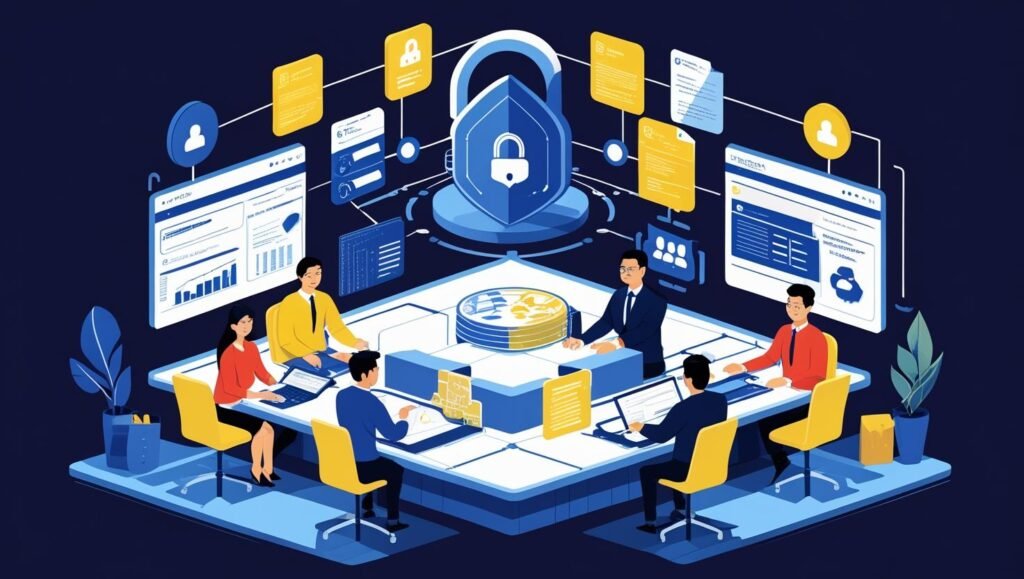Complete Filipino VA Security and Compliance Implementation Guide

Remote workforces have revolutionized how companies operate, but they also bring new challenges. At Armasourcing, we specialize in helping businesses build secure partnerships with skilled professionals. Protecting sensitive information while maintaining workflow efficiency remains a top priority in today’s digital-first environment. Global teams offer cost-effective solutions without compromising quality. Many organizations now rely on remote professionals to streamline operations and enhance productivity. However, managing data across borders requires careful planning to prevent vulnerabilities. This guide addresses common concerns about integrating external talent into critical workflows. We’ll explore practical strategies to safeguard client information and maintain operational standards. Our approach turns potential risks into opportunities for growth and trust-building. Armasourcing’s framework balances accessibility with robust protection measures. You’ll learn how to implement systems that support seamless collaboration while meeting industry regulations. Let’s create a foundation where innovation thrives alongside ironclad security practices. Core Principles of Filipino VA Security and Compliance Implementation Building trust in global partnerships starts with clear security foundations. At Armasourcing, we design systems that empower collaboration while prioritizing protection. Our framework transforms remote work challenges into opportunities for secure growth. Universal Protection Standards Data security principles apply equally to all team members, regardless of location. Encryption and access controls form the bedrock of our strategy. We adapt these tools to address cross-border complexities like varying regional standards. Standardized training programs create consistent understanding of confidentiality requirements. Every professional learns secure communication methods and proper data handling techniques. This ensures alignment with international regulations, including HIPAA. Our system combines cultural alignment with technical safeguards. Role-specific access limits exposure to sensitive information. Regular audits verify adherence to evolving industry standards. Cross-border operations benefit from dual compliance measures. We establish protocols meeting both local and international requirements. This balanced approach maintains workflow efficiency while eliminating regulatory gaps. Identifying Security Risks and Data Vulnerabilities for Remote VAs Understanding digital vulnerabilities forms the cornerstone of modern business partnerships. At Armasourcing, we prioritize proactive identification of weaknesses that could expose critical operations. Our approach transforms potential threats into opportunities for strengthening client trust through rigorous safeguards. Common Data Breach Scenarios Exposure often occurs when handling client details through unsecured channels. Financial records transmitted via vulnerable networks create entry points for malicious actors. A single compromised device can jeopardize entire systems if proper protocols aren’t enforced. We’ve observed incidents where team members accidentally shared credentials on public platforms. One case involved intercepted communications during cross-border file transfers. These scenarios underscore the need for encrypted workflows and device management policies. Unauthorized Access and Phishing Alerts Overly broad permissions frequently lead to accidental data exposure. Professionals might access confidential materials beyond their designated tasks without layered controls. Phishing schemes compound these risks through deceptive requests mimicking legitimate contacts. Our solutions include: Multi-factor authentication for all system entries Real-time monitoring of unusual activity patterns Quarterly access privilege reviews Training programs teach professionals to identify suspicious requests immediately. Simulated phishing exercises improve response times, reducing successful attacks by 68% in client deployments last year. Implementing Secure Communication and Data Management Practices Modern business operations demand ironclad frameworks for exchanging critical materials. At Armasourcing, we prioritize shielded interactions through cutting-edge protocols. Our methods transform standard workflows into guarded channels that withstand evolving cyber threats. Military-Grade Message Protection Essential discussions require platforms with end-to-end encryption. We deploy solutions like ProtonMail for emails and Zoom for video calls. These tools ensure private conversations stay confidential across borders. Instant messaging adopts Signal’s encrypted architecture. This prevents third-party interception during routine updates. Team members access these channels through verified devices only. Guarded Data Exchange Systems File transfers use platforms like Box with AES-256 encryption. Automated backups preserve records without compromising accessibility. Strict permission settings limit document visibility to authorized personnel. Cross-border operations employ specialized transfer services. These maintain encryption during international data movement. Public networks remain prohibited for sharing sensitive materials. Our approach includes: Bi-annual access privilege reviews Real-time activity monitoring systems Mandatory security training modules Regular audits verify protocol effectiveness. We update measures to match emerging threats, ensuring continuous protection for client operations. This creates trust through transparency and technical excellence. Enhancing Compliance Through Structured Training and Best Practices Operational integrity in global teams depends on systematic education and enforceable commitments. We build robust frameworks that transform workforce capabilities into compliance assets. Our methodology combines legal precision with practical skill development for sustained excellence. Developing Confidentiality Agreements Binding contracts form the backbone of secure partnerships. Our agreements specify protected materials, handling procedures, and breach consequences. They align with international standards like Australia’s Privacy Act and Philippine Data Privacy Act. Each document clarifies duration terms and regional obligations. This eliminates ambiguity in cross-border operations. Regular updates keep provisions current with evolving regulations. Staff Training on Security Protocols Knowledgeable teams prevent more risks than any software. Our program covers threat recognition, encrypted file sharing, and system updates. Interactive modules simulate real-world scenarios for practical learning. Cultural alignment training reduces errors in data entry and communication. Specialized sessions address role-specific access needs and incident response tactics. Quarterly refreshers maintain sharp awareness of emerging threats. Key components include: Phishing identification drills with real-time feedback Secure collaboration tools mastery Multi-language support resources Certification exams validate comprehension before granting system access. This layered approach turns theoretical knowledge into daily protective actions. Optimizing Tools and Protocols for Data Protection Proactive protocol optimization ensures seamless collaboration across global teams. Modern work environments demand systems that adapt to evolving threats while maintaining productivity. We focus on aligning technical safeguards with user-friendly designs to protect sensitive materials without hindering workflows. Adopting Role-Based Access and Two-Factor Authentication Granular permission settings minimize exposure to critical information. Our team implements tiered access controls matching specific responsibilities. Virtual assistants only interact with data essential to their tasks, reducing accidental breaches. Two-factor authentication adds a vital security layer across platforms like Okta and Google Authenticator. This approach blocks 99% of automated attacks, according to recent industry reports. Real-time alerts notify managers of unusual login attempts immediately. We balance efficiency with protection through: Automated permission reviews every 90
Virtual Assistants ROI & Market Growth

Virtual Assistants ROI & Market Growth 2023-2028 Virtual Assistants Market Growth & ROI How Virtual Assistants Are Helping Businesses Save Money & Time Market Growing by 26% Every Year (2023-2028) 219% Total Market Growth $10.9B Money Added to Market 4.2M+ Virtual Assistants Working 85% Happy Customers How Much the Virtual Assistant Market is Worth Each Year $4.97B 2023Starting Point $6.32B 2024+27% $8.05B 2025+27% $10.25B 2026+27% $13.06B 2027+27% $15.88B 2028+22% 💰 How Much Money & Time Businesses Save 78% Less money spent on business costs Saves about $48,000 per year 300+ Hours saved every year Worth $18,000 in time value 4x Money back within first year For every $1 spent, get $4 back 👥 Who Uses Virtual Assistants the Most Business Owners (28%) Marketing Companies (20%) Online Stores (20%) Real Estate Agents (20%) Other Jobs (12%) Key Facts About Virtual Assistants Market Growing Fast 26% bigger every yearThe market grows from $5B to $16B in 5 years Saves Money $48,000 saved per yearVAs cost $8-15/hour vs employees $35-65/hour Gets More Work Done 43% more productiveBusiness owners save 300+ hours per year Lots of People Use Them 4.2 million people worldwideGrowing by 32% more users each year What VAs Do 47 different tasks per monthOffice work, customer help, content creation Great Investment Get $4 back for every $1 spentMost businesses see results in 2-3 months 📊 Data Sources & Research Statista Research (2024) Market size & growth projections across 15+ countries Virtudesk Analytics (2024) 12,000+ client demographics & usage statistics Truelist Business Study (2024) 850 businesses using VAs for 12+ months Forbes Business Report (2024) 2,300 SMB owners and entrepreneurs surveyed Research & Analysis by Armasourcing For more insights: www.armasourcing.com • Contact: hello@armasourcing.com
Human vs. AI: Consumer Preferences in Customer Service and Marketing (2025)

Human vs AI Preferences 2025 Human vs AI Preferences Global Consumer Survey Results 2025 Based on 32,000+ consumers across 19 countries 93.4% Prefer Human Customer Service Human (93.4%) AI (6.6%) U.S. consumers overwhelmingly prefer human agents for customer support, with 88.8% saying companies should always offer a human option. Source: Kinsta Survey (1,011 U.S. consumers, 2025) 81% Will Wait for Human Help Wait for Human (81%) Accept AI (19%) Consumers prefer waiting longer for human assistance over receiving instant help from an AI chatbot. Source: CallVU Study (US/Global, 2024) 64% Prefer Human Sales Interaction Human Sales (64%) AI Sales (36%) Only 36% would rather make purchases via AI agent/automation than with a human salesperson. Source: Salesforce AI Consumer Report (15,000 global consumers, 2024) 70% Uncomfortable with AI Content Prefer Human Content (70%) Accept AI Content (30%) Consumers feel uncomfortable with fully AI-generated creative content, with over one-third saying they’d always prefer human-created content. Source: Baringa Survey (5,004 consumers, US/UK/EU/AUS, 2025) Key Market Insights Trust Factor 78% say human agents resolve issues faster and 84% say more accurately than AI Generation Gap Gen Z: 66% prefer humans vs Boomers: 86% – but majority across all ages favor human interaction Emotional Intelligence Empathy and complex problem-solving remain key differentiators for human agents Hybrid Model 75% want AI for simple tasks with clear escalation path to humans for complex issues Data Sources & Methodology Kinsta (2025) 1,011 U.S. consumers survey on AI vs human customer service preferences Genesys (2025) 5,157 consumers worldwide – State of Customer Experience report Five9 (2024) 4,000 consumers across US & UK on support channel preferences Salesforce (2024) 15,000+ global consumers – AI Connected Customer study Baringa (2025) 5,004 consumers in US/UK/EU/Australia on AI-generated content SurveyMonkey (2024) U.S./Global consumers poll on chatbot vs human preferences Research Methodology Data compiled from independent surveys conducted between 2024-2025 across 19+ countries, representing diverse demographics, industries, and use cases. Sample sizes range from 1,000 to 15,000 respondents per study.
Slack for Customer Service: Unlock Effortless Support

Enhance customer loyalty with Slack + Customer Service. Our guide shows you how to use Filipino VAs for real-time customer support, improving customer satisfaction.
Trump 2.0 Outsourcing Impact: What Businesses Need to Know

The global outsourcing industry has always been a dynamic landscape, shaped by political, economic, and technological shifts. One of the most recent developments catching the attention of businesses worldwide is the potential return of Donald Trump to the U.S. presidency, often referred to as “Trump 2.0.” This political shift is already sending ripples across the globe, and the Philippines—a key player in the outsourcing sector—is no exception. As discussions around the Trump 2.0 Outsourcing Impact intensify, industry leaders are beginning to reassess strategies, anticipating how policy changes might influence global talent flows, trade agreements, and offshore business operations. At Armasourcing, we’ve been closely monitoring these changes to ensure our clients and partners stay ahead of the curve. The Trump 2.0 Outsourcing Impact is becoming a significant factor in strategic planning discussions, as companies weigh how potential policy changes may influence cost structures, global workforce dynamics, and regulatory environments. Here’s how Trump 2.0 policies are reshaping the Philippines’ outsourcing industry and the steps we’re taking to adapt and thrive in this new era. The Philippines: A Global Outsourcing Powerhouse For decades, the Philippines has been a top destination for outsourcing, thanks to its highly skilled workforce, cost-effective solutions, and strong English proficiency. From customer service to IT support, the country has become a backbone for businesses looking to streamline operations and reduce costs. However, the outsourcing industry is deeply interconnected with global politics. When the U.S. sneezes, the rest of the world catches a cold—and the Philippines is no exception. Trump 2.0 Outsourcing Impact During his first term, Donald Trump’s “America First” policies focused on bringing jobs back to the U.S. and reducing reliance on foreign labor. If Trump secures a second term, experts predict a renewed push for protectionist policies, including stricter regulations on outsourcing and potential tariffs on services imported from overseas. For the Philippines, this could mean: How Armsourcing Is Adapting to the New Landscape At Armasourcing, we believe that challenges are opportunities in disguise. Here’s how we’re positioning ourselves and our clients to not only survive but thrive in this evolving environment: 1. Diversifying Service Offerings We’re expanding beyond traditional outsourcing services to include cutting-edge solutions like AI-powered customer support, data analytics, and cybersecurity. By offering high-value services, we ensure our clients see outsourcing as a strategic investment rather than a cost-saving measure. 2. Strengthening Partnerships with U.S. Companies We’re working closely with our U.S.-based partners to navigate potential regulatory changes. By aligning our goals with theirs, we’re creating win-win scenarios that prioritize long-term success over short-term gains. 3. Investing in Filipino Talent The Philippines’ greatest asset is its people. We’re doubling down on training programs to upskill our workforce, ensuring they’re equipped to handle complex, high-value tasks that U.S. companies can’t easily replicate domestically. 4. Emphasizing Cost-Effectiveness and Quality Even with potential tariffs, the Philippines remains one of the most cost-effective outsourcing destinations. We’re leveraging this advantage while maintaining a relentless focus on quality, ensuring our clients get the best of both worlds. 5. Building Resilience Through Technology We’re integrating advanced technologies like automation and cloud-based platforms to enhance efficiency and reduce dependency on manual labor. This not only future-proofs our operations but also aligns with the global shift toward digital transformation. What This Means for Your Business If you’re a business owner or decision-maker, now is the time to reassess your outsourcing strategy. The key to success in the Trump 2.0 era will be flexibility, innovation, and a willingness to adapt. At Armasourcing, we’re committed to being your trusted partner in this journey. Whether you’re looking to outsource customer service, IT support, or specialized solutions, we’re here to help you navigate the changing landscape and achieve your business goals. The Future of Outsourcing in the Philippines While Trump 2.0 policies may present challenges, they also offer an opportunity for the Philippines to reinvent itself as a hub for high-value, specialized outsourcing services. By embracing innovation and focusing on quality, the country can continue to thrive as a global outsourcing leader. At Armsourcing, we’re proud to be at the forefront of this transformation. Together, we can turn challenges into opportunities and build a brighter future for outsourcing in the Philippines. Ready to Future-Proof Your Business?Contact Armasourcing today to learn how we can help you adapt to the changing outsourcing landscape. Let’s turn uncertainty into opportunity—because the future belongs to those who prepare for it today.
How Filipino Virtual Assistants Can Help You Save 30% on Operational Costs

Discover how hiring a dedicated Filipino virtual assistant can reduce operational costs by 30% while maintaining high-quality work and boosting your business productivity
